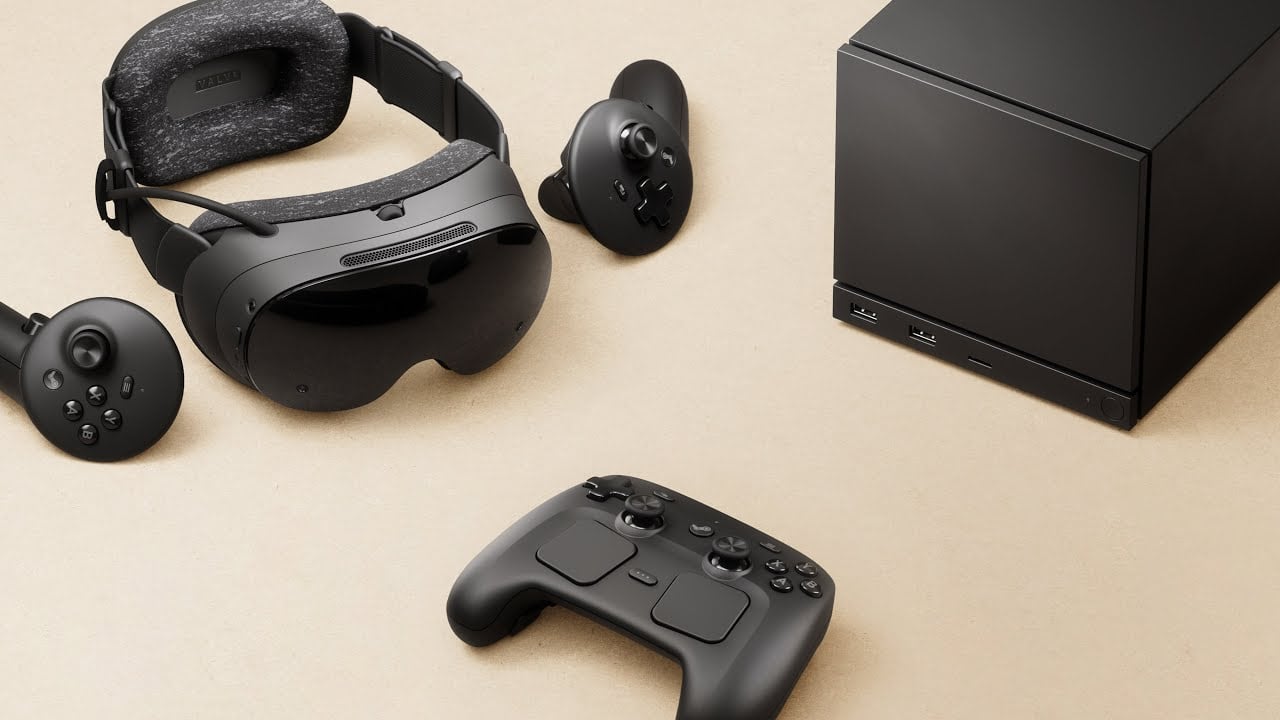
Summary:
Valve is stepping further into the living room with the Steam Machine, a cube-shaped mini PC that behaves like a console while still tapping into the flexibility of Steam and SteamOS. Instead of building a traditional tower or another handheld, Valve has gone for a compact box that sits neatly under your TV and focuses on one goal: making your Steam library feel as simple to use as turning on a console. Paired with a new dedicated controller and the Steam Frame VR headset, the plan is clear: Steam Deck was the test run, and Steam Machine is the bigger leap into mainstream gaming spaces. You still get the strengths of a PC—mod support, wide game choice, flexible settings—but wrapped in a form that’s designed to be picked up and played by anyone in the house. With a launch planned for 2026, Valve is quietly positioning itself as a serious rival to Nintendo, Sony, and Microsoft, not by copying them, but by leaning into what makes PC gaming special while smoothing out all the usual rough edges.
Valve’s new Steam Machine
Valve has always been most comfortable in the PC world, so seeing the company commit to a cube-shaped, console-style machine feels like a big moment. Steam Deck proved that a carefully tuned combination of hardware, SteamOS, and the Steam interface can feel surprisingly friendly, even if you’ve never built a PC in your life. Steam Machine takes that idea off the couch in your hands and drops it under your TV as a dedicated box. You plug it into HDMI, pair the new controller, sign into Steam, and you’re ready to go. Instead of browsing complicated launchers or wrestling with settings just to get to your games, you’re greeted with a television-first interface built on the same backbone that already powers Steam Deck and other SteamOS devices. The message from Valve is straightforward: you shouldn’t need a sprawling tower or a degree in drivers to enjoy PC-style gaming on your biggest screen.

Cube-sized design and GameCube-style nostalgia
The first thing that grabs attention is the shape. By going with a compact cube, Valve invites instant comparisons to Nintendo’s GameCube, a system many players remember fondly for its playful look and easy portability. Steam Machine plays into that nostalgia without feeling like a copy. The modern cube is more minimal, more understated, and clearly built to disappear next to a soundbar or streaming box until you power it on and that front light kicks in. A small footprint matters more than ever when TV stands are already packed with set-top boxes, routers, and chargers, and this cube squeezes proper gaming hardware into a size that doesn’t dominate the shelf. You can imagine it sitting next to a Switch dock or a media streamer and not looking out of place. That mix of subtle design and quiet nods to the past sets the tone: familiar enough to feel friendly, new enough to feel exciting.
SteamOS, Steam, and the living-room PC feel
Under the hood, Steam Machine runs SteamOS, Valve’s Linux-based operating system designed around gaming and controller input. On Steam Deck, SteamOS already feels like something between a console interface and a PC launcher, with big tiles, quick access to your library, and a focus on getting you into games fast rather than burying you in menus. Bringing that same philosophy to the television makes a lot of sense. Instead of juggling a keyboard and mouse on the sofa, you navigate everything with the dedicated controller, from game installs and cloud saves to store purchases and remote downloads. Because it’s built on Steam, you gain the benefits of years of features: cloud sync, remote play, family sharing, and a massive library that stretches from indie curios to big-budget blockbusters. It’s still a PC at heart, but one that behaves politely in a living room, waking quickly, suspending games reliably, and keeping the focus on play instead of maintenance.
How Steam Machine compares to Steam Deck and classic gaming PCs
It’s natural to wonder where Steam Machine fits when Steam Deck already exists and gaming PCs are everywhere. Think of Steam Deck as the handheld that goes wherever you do, while Steam Machine is the box that stays home on the big screen. A custom, console-like design means Valve can tune cooling, power draw, and performance specifically for a living-room setup instead of handheld battery limits. That gives Steam Machine room to push resolutions and frame rates that feel more in line with modern consoles, especially when paired with image-enhancing tech. Compared to a traditional PC, the trade-off is straightforward: you lose some upgradability, but you gain simplicity. There’s no guessing about which GPU fits in which case, or whether your power supply can handle the latest card. Valve chooses the configuration, you plug it in, and it just works. For many players who like PC flexibility but hate PC fuss, that balance is very appealing.
Dedicated Steam Machine controller and couch-friendly controls
A living-room system lives or dies by its controller, and Valve clearly knows this after experimenting with the original Steam Controller and fine-tuning inputs on Steam Deck. The new dedicated pad aims to bridge the best of both worlds: traditional sticks and buttons for familiarity, paired with the kind of precision touch and gyro tricks that PC players already enjoy on Deck. The idea is simple: if you’ve ever felt clumsy trying to navigate a PC launcher with a generic controller, this pad should feel like the opposite. Menus, text input, and fine camera adjustments are designed with this layout in mind. For families, that matters a lot. Hand someone who usually plays on console a Steam Machine controller and they shouldn’t need a tutorial—just a quick rundown of a few unique shortcuts and they’re off. When a device is meant to sit in the living room as a shared system, reducing friction around basic controls is almost as important as raw performance.
Steam Frame VR headset and how it fits into Valve’s hardware family
Alongside the cube itself, Valve is preparing the Steam Frame VR headset, a successor to the Index that leans into wireless play and standalone features while still integrating tightly with Steam. This headset serves as the third piece in Valve’s hardware triangle: Steam Deck for portable play, Steam Machine for TV gaming, and Steam Frame for immersive VR. Instead of treating VR as a separate silo, Valve’s approach hints at a future where your VR library, flat-screen games, and handheld titles all live in the same ecosystem. You sign into the same account, you browse the same store, and your purchases carry over no matter where you’re playing. For players already invested in Steam, that continuity is powerful. It lowers the psychological barrier to trying VR or a new form factor because you’re not starting from zero every time you buy a new device. The hardware may change, but your library and habits move with you.
Power and performance expectations for 2026
While Valve is still holding back exact benchmarks and final specs, the broad picture is clear: Steam Machine is meant to outpace Steam Deck by a healthy margin and sit comfortably next to current consoles in day-to-day use. By designing a fixed configuration instead of an open PC platform, Valve can optimize for a specific thermal envelope, pick components that play nicely together, and test a focused set of scenarios over and over. That usually leads to smoother real-world performance than the raw numbers alone suggest. For players, what matters is simple: stable frame rates, solid image quality, and fast loading when they hit the power button. Combined with SteamOS optimizations and features like suspend and resume, the goal is to make your Steam library feel less like a pile of executables and more like a curated shelf of games ready to hop in and out of at will. As the launch window approaches and more real-world tests appear, this will be the area to watch closely.
Steam Machine as a fourth pillar next to Nintendo, PlayStation, and Xbox
For years, living-room discussions revolved around three names: Nintendo, Sony, and Microsoft. Valve nudged in from the side with Steam Link and Steam Deck, but those devices still felt like sidekicks rather than direct rivals. Steam Machine changes that. A cube-shaped box with a dedicated controller, launch window, and VR partner device looks and sounds like a console, even if it’s technically a PC under the hood. The difference is that Valve isn’t starting from scratch. Steam already has a massive, loyal user base and a store people know inside out. When someone buys a Steam Machine, they’re not entering a new walled garden; they’re bringing an existing library into a more relaxed setting. That makes Valve a serious candidate for the unofficial “fourth pillar” in living-room gaming—standing shoulder to shoulder with Switch, PlayStation, and Xbox, but with the unique twist that everything is powered by a storefront and operating system designed first for PC.
Who Valve is targeting with this hardware
So who is Steam Machine really for? The obvious answer is PC players who are tired of dragging a tower into the living room or running a long HDMI cable across the floor. If you already own a library full of Steam games and you’d love to enjoy them on a big TV without juggling a mouse on the couch, Steam Machine practically sells itself. But there’s another group clearly in the crosshairs: players who grew up on consoles and are curious about PC-style choice but wary of the complexity. For them, Steam Machine offers a middle road—more openness than a locked-down console, less hassle than building a rig from parts. Add in families who share one TV and want something everyone can navigate, and you end up with a surprisingly broad audience. In many ways, Steam Machine feels like an invitation to people who have looked at PC gaming from a distance and decided it looked like too much work.
Potential downsides, questions, and early buying advice
No hardware launch is perfect, and Steam Machine will come with trade-offs that buyers should consider. A fixed configuration means you’re not swapping GPUs a few years down the line, so long-term power will depend on how strong the initial hardware really is and how well SteamOS continues to evolve. Game compatibility on Linux-based systems has improved dramatically, but there will always be edge cases that behave differently compared to Windows. That’s worth keeping in mind if you rely on specific mods, niche older titles, or complex launchers. Pricing will also play a huge role; if Steam Machine lands too close to custom PC builds or console bundles, some players may hesitate. Early on, the smartest move is to treat the system as a focused living-room companion rather than a replacement for every machine you own. Watch how Valve supports it, see how frequently firmware and OS updates arrive, and pay attention to how reviewers describe noise, heat, and day-to-day quirks before jumping in.
How the Steam Machine could change living-room gaming over the next few years
Looking a little further ahead, Steam Machine has the potential to shift expectations around what a living-room system can be. If Valve pulls this off, more players may start to view the divide between “PC” and “console” as a spectrum rather than a hard line. Imagine picking up your Steam Deck on the train, docking it at home for quick multiplayer sessions, hopping into VR with Steam Frame when you want something more intense, and having all of it feel like one cohesive family instead of three separate projects. That kind of continuity has always been a dream in gaming, but it usually gets tangled in different storefronts, account systems, and hardware quirks. By doubling down on SteamOS and building hardware that serves different moments in your day, Valve could nudge the whole industry toward more flexible, player-friendly setups. Even if you never buy this cube, the pressure it puts on other companies to be more open and adaptable might still benefit you in the long run.
Conclusion
Steam Machine isn’t just another mini PC; it’s Valve’s clearest statement yet that your Steam library belongs in the living room as much as it does on a desk or in your hands. The cube-shaped design, SteamOS backbone, dedicated controller, and Steam Frame VR headset all point in the same direction: giving you more ways to enjoy the games you already love without making you jump through technical hoops. There are still important questions around long-term performance, pricing, and compatibility, and anyone considering a day-one purchase should keep a close eye on those details as launch gets closer. Even so, the bigger picture is hard to ignore. With Steam Deck proving the concept and this cube aiming straight for the TV, Valve is steadily carving out space alongside Nintendo, Sony, and Microsoft. If you’ve ever wished PC gaming felt just a bit more relaxed and console-style without losing what makes it special, Steam Machine might be the moment you’ve been waiting for.
FAQs
- What is Valve’s Steam Machine?
- Steam Machine is a cube-shaped mini PC built by Valve that runs SteamOS and is designed to live under your TV. It focuses on playing games from your Steam library with a console-like user experience, using a dedicated controller tuned for living-room play.
- How is Steam Machine different from Steam Deck?
- Steam Deck is a handheld that prioritizes portability and battery life, while Steam Machine is a stationary box aimed at higher resolutions and more comfortable long sessions on a big screen. Both rely on SteamOS and your existing Steam account, but they serve different moments in your day.
- Do I need a keyboard and mouse to use Steam Machine?
- For most people, no. Steam Machine is built around a new controller, and the interface is designed so you can browse your library, install games, and manage basic settings from the sofa. A keyboard and mouse are still useful for desktop mode or specific games, but they’re not required for everyday use.
- What is the Steam Frame VR headset, and how does it relate to Steam Machine?
- Steam Frame is Valve’s upcoming VR headset that focuses on wireless play and closer integration with SteamOS. While it can pair with a PC in different ways, having a Steam Machine in the living room gives you a natural base station for VR, flat-screen games, and media, all running through the same ecosystem.
- Who should consider buying Steam Machine when it launches?
- Steam Machine is a strong fit if you already own a sizable Steam library, enjoy the idea of PC gaming, but dislike dealing with tower builds and cables. It also makes sense if your household shares one TV and you want something that feels approachable for everyone, with the flexibility of PC-style game choice rather than a closed console lineup.
Sources
- Ten years later, the Steam Machine is officially back, and it might steal your console’s lunch money, GamesRadar+, November 12, 2025
- Valve Just Unveiled New Hardware: Meet The New Steam Frame, Steam Machine & Controller, HotHardware, November 12, 2025
- Valve has stopped manufacturing its Index VR headset, The Verge, November 12, 2025
- Introducing Steam Deck OLED, Valve, accessed November 13, 2025
- SteamOS, Valve, accessed November 13, 2025














